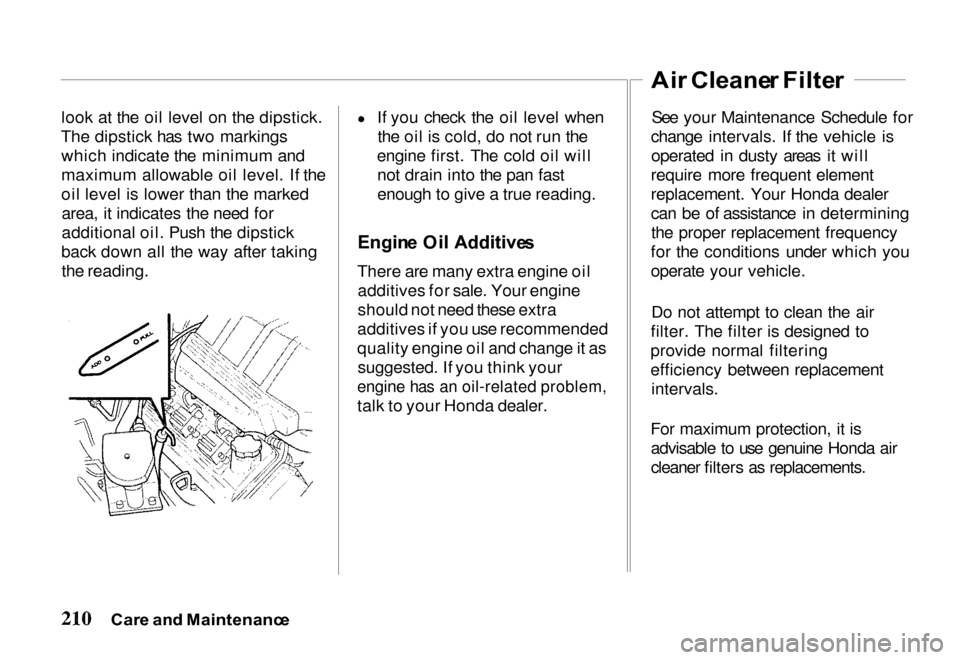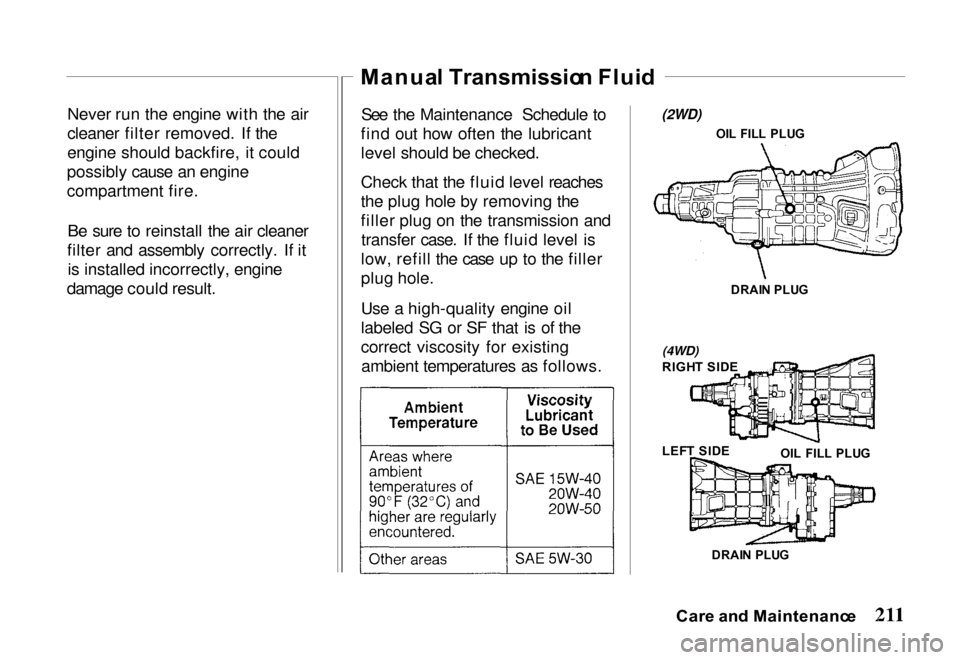2000 HONDA PASSPORT air filter
[x] Cancel search: air filterPage 170 of 267

air cleaner, so it's important to
replace the air cleaner filter at
required intervals. See "Care and Maintenance." A dirty air cleaner
filter reduces engine performance
and can waste fuel.
Air Conditioning
Turn off the air conditioning whenit is not needed. The air
conditioning compressor is not on
in this position and the reduced
engine load can improve fuel
economy.
Tuned Engine
An engine that is properly
maintained will provide better
fuel economy than one that is not.
One misfiring spark plug will cut
fuel economy significantly, and
will make a difference in the
amount of pollution emitted from
your vehicle.
Excessive Weight
Fuel economy is related to thework the engine must do. The
heavier the load, the more fuel it takes to run your vehicle. Keep
weight to a minimum by removing
unnecessary luggage or cargo.
Tire Inflation
Underinflation not only causes
needless tire wear but can also
waste fuel. It's a good idea to
check tire pressure often and keep your tires inflated to the pressures
shown on the tire placard located
on the driver's doorjamb.
Wheel Alignment
Improper alignment will cause the
front tires to roll at an angle that
will result in faster tire wear. It takes power to overcome this
improper alignment, which, inturn, wastes fuel.
Use of 4-Wheel Drive
In normal driving, put the 4WD-2WD switch in the 2WD
position.
Driving Tip s
Page 194 of 267

Car
e an d Maintenanc e
This section explains why it is important to keep your vehicle
well maintained and to follow
basic maintenance safety
precautions.
This section also includes Maintenance Schedules for
normal driving and severe driving
conditions, a Maintenance
Record, and instructions for simple maintenance tasks you
may want to take care of yourself.
If you have the skills and tools
required to perform more complex
maintenance tasks on your Honda,
you may want to purchase the Service Manual. See page 249 for
information on how to obtain a
copy, or see your Honda dealer. Service Station Information . 193
Fuel Fill Cap .......... 193Fuel Recommendation ... 194
Fuel Tank Capacity ..... 194
Engine Oil Recommendation ...... 194
Windshield Washer ..... 194
Tire Inflation Pressures .. 194 Battery ............... 194
Hood Release .......... 195
Engine Oil Dipstick ..... 196
Fuel Requirements ........ 196 Oxygenated Fuels ...... 196
Maintenance Safety ....... 197 Important Safety
Precautions .......... 198
Maintenance Schedule ..... 199
Required Maintenance Record 202
Owner Safety Checks ...... 204
Engine Oil and Filter ...... 207 Proper Quality Oil ...... 207 Change Interval ........ 207
Oil
Change ........... 208
Oil Filter Installation . 208
Oil Viscosity .......... 209
Oil Level Check ....... 209
Engine Oil Additives ... 210
Air Cleaner Filter ........ 210
Manual Transmission Fluid 211
Automatic Transmission Fluid .................. 212
Front (4WD) and Rear Axles ............. 212
Engine Cooling System ... 213
Other Required Maintenance 215 Brake Master Cylinder . . 215
Shift-on-the-Fly System
. 216
Front Whee
l Bearings ... 216
Hood Latch and Hinges . 217
Air Conditioning ....... 217 Body Lubrication ...... 217
Car e an d Maintenanc e
Page 204 of 267

R — Replace L — Lube I — Inspect After inspection, clean, adjust, repair or replace if necessary.
Check oi
l and coolant level at each fuel stop.
Under severe driving conditions, service these items more often. These conditions are: Service for severe driving conditions
Repeated short trips in cold weather Frequent idling and/or frequent low-speed operation Change engine oil and filter - Every 3,750 miles (6,000 km) Driving in dusty areas Towing a trailer or 3 months
Change rear axle oil - Every 15,000 miles (24,000 km)
Care an d Maintenanc e
Page 213 of 267

look at the oil level on the dipstick.
The dipstick has two markings which indicate the minimum and
maximum allowable oil level. If the
oil level is lower than the markedarea, it indicates the need for
additional oil. Push the dipstick
back down all the way after taking the reading. If you check the oil level when
the oil is cold, do not run the
engine first. The cold oil will not drain into the pan fast
enough to give a true reading.
Engin e Oi l Additive s
There are many extra engine oil additives for sale. Your engine
should not need these extra
additives if you use recommended
quality engine oil and change it as suggested. If you think your
engine has an oil-related problem,
talk to your Honda dealer. Ai
r Cleane r Filte r
See your Maintenance Schedule for
change intervals. If the vehicle is operated in dusty areas it will
require more frequent element
replacement. Your Honda dealer
can be of assistance in determining the proper replacement frequency
for the conditions under which you
operate your vehicle.
Do not attempt to clean the air
filter. The filter is designed to
provide normal filtering
efficiency between replacement intervals.
For maximum protection, it is advisable to use genuine Honda air
cleaner filters as replacements.
Car e an d Maintenanc e
Page 214 of 267

Never run the engine with the air
cleaner filter removed. If the
engine should backfire, it could
possibly cause an engine
compartment fire.
Be sure to reinstall the air cleaner
filter and assembly correctly. If it is installed incorrectly, engine
damage could result. Manua
l Transmissio n Flui d
See the Maintenance Schedule to
find out how often the lubricant
level should be checked.
Check that the fluid level reaches
the plug hole by removing the
filler plug on the transmission and transfer case. If the fluid level is
low, refill the case up to the filler
plug hole.
Use a high-quality engine oil
labeled SG or SF that is of the
correct viscosity for existing ambient temperatures as follows.
(2WD)
OIL FIL L PLU G
DRAI N PLU G
DRAI N PLU G
Car e an d Maintenanc e
(4WD)
RIGH
T SID E
LEF T SID E
OIL FIL L PLU G
Page 254 of 267

Inde
x
ABS. See Anti-Lock Brake
System
Accessories, Installation .... 169
ACCESSORY
(Ignition Key Position) ...... 97
Accessory Power Outlets ..... 113
Adding AutomaticTransmission Fluid .... 212
Brake Fluid ............ 215
Clutch Fluid ............ 219
Engine Oil ............ 208
Manual Transmission Fluid .... 211
Power Steering Fluid ..... 219
Radiator Coolant ........ 214
Windshield Washer Fluid ..
194
Adjustments
Head
Restraints .......... 12
Mirrors
Exterior ............ 101Interior ............. 101
Power. ............. 101
Seat-Backs .......... 11,
89
Reclining the Rear ...... 93
Seats, Front ......... 10,
89
Steering Wheel ..... 15,
111
Adults, Protecting ........... 10
Airbags (SRS) ............. 7
Serious Risk to Children .... 19
Air Cleaner Filter ......
166, 210
Air Conditioning
Maintenance ........... 217
Usage ................. 116
Air Filter. See Air Cleaner Filter
Air Outlets (Vents) ......... 120
Air Pressure, Tires ......... 235
Alcohol and Driving ........ 4
Alcohol in Gasoline ........ 196
Alternator Belt. See Drive Belts
Antifreeze ................ 213
Anti-Lock Brake System
Indicator Lights .......... 65
Operation .............. 155
Anti-Theft Steering Column Lock ..... 98
System .................
..... 148
Appearance Care. See Cleaning
Ashtray .................. 112
Assist Grip ..............
111
Audio System ............. 121
Page 258 of 267

Emergency, In Case of ...... 179
Charging System Indicator . 60Check Engine Light ....... 61
Checking the Fuses ...... 189
Engine Overheating ...... 186 Jump Starting ........... 180
Malfunction Indicator Lamp 61Oil Pressure Indicator ..... 62
Emissions Controls ........ 245
Engine
Belts .................. 218
Break-in ............... 154
Check Light ............. 61Coolant Temperature Gauge 58
Identification Number .... 228
Malfunction Indicator Lamp 61 Oil
Capacity ............. 231
Recommendation ...... 194
Oil Pressure Indicator ..... 62 Overheating ............ 186
Specifications .......... 231
Starting ............... 153
Ethanol in Gasoline ........ 197
Evaporative
Emission Controls ........ 246
Exhaust Fumes ............ 44
Expectant Mothers,
Use of Seat Belts by ...... 16
Exterior, Cleaning the ...... 220
Fabric, Cleaning.
See Interior Cleaning
Fan Control Lever ......... 117
Features,
Comfort and Convenience . . 115
Filling the Fuel Tank ....... 193 Filters
Air .................. 210
Oil .................. 208
5-Speed Manual Transmission Checking Fluid Level ... 211Shifting ................ 81
Flashers, Hazard Warning ....
74
Flat Tire
, Changing a ....... 182
Fluids Automatic Transmission . .
212
Capacity ............
. 233
Brake ................. 215
Clutch ................ 219
5-Speed Manual Transmission .......... 211
Capacity ............. 233
Power Steering .......... 219
Windshield Washer ...... 69
FM Stereo
Radio Reception ........ 132
Page 263 of 267

Protecting Children .......... 18
AdditionalSafety Precautions ........ 21
All Children Must Be Restrained ...... 18
Children Should Sit in the Back Seat ....... 19
General Guidelines for Using Child Seats ........ 21
If a Child Requires Close Attention .......... 20
If You Must Drive With Several Children .... 20
Passenger's Airbag Poses
Serious Risks to Children .. 19
Protecting Infants ......... 25
Protecting Larger Children . 33
Protecting Small Children . . 29
Using Child Seats With Tethers ............ 36 Radiator Overheating ....... 186
Radio/Cassette Sound System ........... 121
Radio/Cassette/CD Sound System ........... 129
Rear End Towing .......... 189
Rear Lights, Bulb Replacement ........ 239
Rear Seat, Folding .......... 91
Rear View Mirror .......... 101 Rear Window Defogger ...... 72
Rear Window Wiper and Washer ............... 72
Reclining the Seat-Backs Front .............. 11, 89
Rear .................. 93
Recommended Shift Speeds . . 82 Reduced Power Indicator .... 62
Replacement Information Air Cleaner Element ..... 210
Coolant .......... 200, 214
Engine Oi
l and Filter ..... 207
Fuses ................. 236
Light Bulbs ............ 239 Schedule .............. 200
Spark Plugs ............ 231
Tires .................. 162
Replacing Seat Belts After a Crash ............ 40
Reporting Safety Defects .... 245
Reserve Tank, Coolant ...... 213
Restraint, Child ............ 18
Reverse Gear Position ...... 75
Rotation, Tire ............. 162
Rust Protection ............ 221